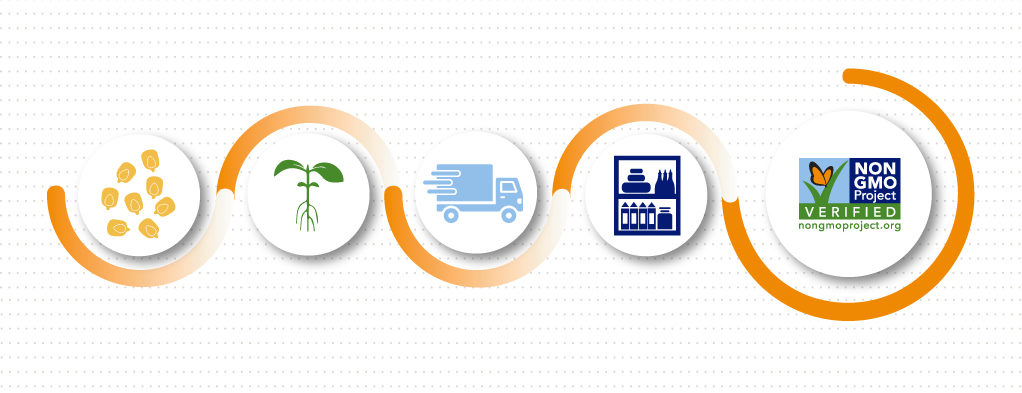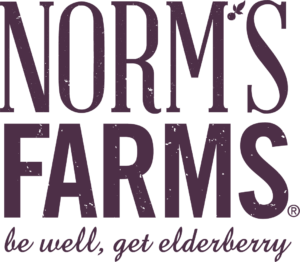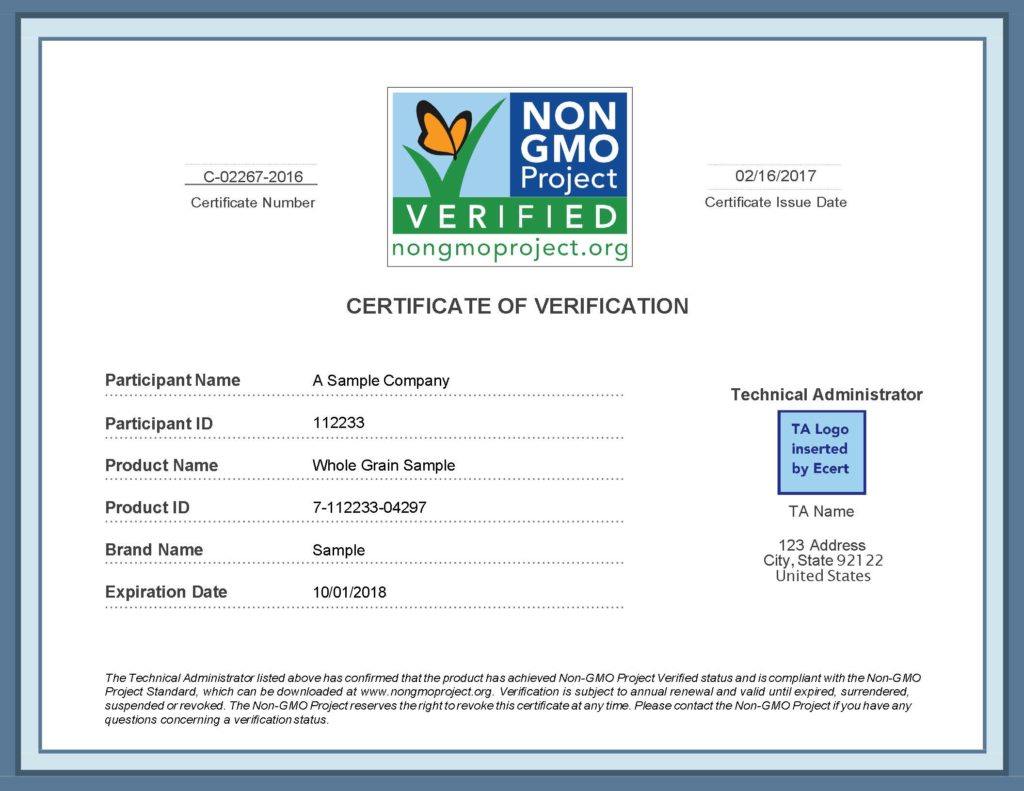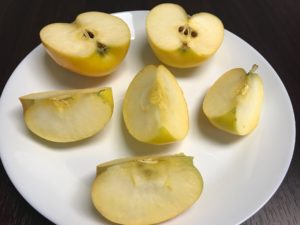
It’s not just grocery shoppers who are looking for Non-GMO Project Verified products — the brands you know and trust look for the Butterfly when they source ingredients too! As shoppers demand more transparency from food brands, brands are in turn demanding more transparency and more documentation from their suppliers. For the supply chain participants who make our favorite ingredients, this means proof of Non-GMO Project Verification is more important than ever before.
Non-GMO Project Certificate of Verification
Just like consumers look for the Verified mark as proof a product is really non-GMO, food producers look for a Non-GMO Project Certificate of Verification (COV). Each Verified product receives a COV with an expiration date, a unique certificate number, and a scope of verification: all the information downstream clients need to confirm that the ingredients they seek are truly Non-GMO Project Verified.
Getting a product Verified is hard work, but the good news is that verification can follow an ingredient all the way through the supply chain. For example, one food company might choose to have their corn flour evaluated. When they sell that Verified corn flour to a company that makes Verified corn tortillas, the tortilla company does not need to spend time and money getting that flour re-tested. Instead, they simply follow best practices to prevent contamination and show the COV from that flour to their third-party Technical Administrator. This helps Verified brands pass savings on to consumers without compromising quality.
 Self-Made Claims Are Not Enough!
Self-Made Claims Are Not Enough!
You may have seen “self-made” non-GMO claims on products before. Without the backing of a third-party certifier like the Non-GMO Project, these claims are asking for trust with no proof. These self-made claims are not good enough for most people anymore. Trusted non-GMO certifications are now all but mandatory in the natural product industry, especially as brands prepare to comply with new laws and store policies. For example:
The National Bioengineered Food Disclosure (a new law in the United States) will require many food producers to demonstrate that their products do not contain GMOs. As thousands of brands prepare for compliance with this new law, they are all seeking non-GMO goods accompanied by proper documentation.
Non-GMO Project COVs are particularly invaluable to participants who wish to sell their product in Whole Foods Market, which will require third-party verification for products making a non-GMO claim by 2022. As more stores develop non-GMO purchasing and labeling policies, brands increasingly need to prove their Verified status to secure space on store shelves.
Look for the Butterfly
The Non-GMO Project doesn’t just test for GMOs in finished products, it demands testing and transparency all the way back through the supply chain. For brands, a COV is proof of that testing and transparency. For consumers, the Non-GMO Project Verified mark means the same thing: this product earned North America’s most meaningful label for GMO avoidance.

Manukora is excited to announce that all products from their Manuka honey range are now Non-GMO Project Verified, North America’s most rigorous third-party verification for non-GMO foods and products.
Manukora honey is sourced from untouched forests in remote regions in New Zealand. The remoteness of our sourcing regions means our bees have an endless source of nectar to feed from. Our honey is a direct product of the environment it was created in — no quick fixes here. Quality honey is our priority, always.
Manukora uses Trust Code™ technology to validate its quality and guarantee the authenticity of our Manuka honey. This unique product serialisation allows the honey in each jar to be traced back to the hive it came from. Giving our customers ultimate transparency about the products they are receiving allows them to make the best decisions for themselves and others.
Our commitment to sustainable beekeeping and reducing our environmental impact is central to everything we do at Manukora. We ensure honey from the previous season is left in the hive so there is enough to keep our bees throughout the winter providing them with natural nutrition. By doing this, we ensure the good health of our bees, our honey and ultimately our customers.
The Non-GMO Project verification currently applies to the following Manukora products:
● MGO 50+ Raw Multifloral Manuka Honey
● MGO 100+ Raw Multifloral Manuka Honey
● UMF 10+ (MGO 265+) Raw Manuka Honey
● UMF 15+ (MGO 500+) Raw Manuka Honey
● UMF 20+ (MGO 830+) Raw Manuka Honey
● UMF 24+ (MGO 830+) Raw Manuka Honey
For more information visit our website www.manukora.com or connect with us on Instagram (@manukorahoney) or Facebook (Manukora).
Consumers have been asking for GMO transparency for more than two decades. As store buying policies and federal regulations are catching up with consumer expectations, self-made GMO claims are no longer sufficient for clients in the natural food supply chain. As shoppers demand more transparency from food brands, brands are in turn demanding more transparency and more documentation from their suppliers. For supply chain participants, this means proof of Non-GMO Project Verification is more important than ever before.
Non-GMO Project Certificates of Verification
A Non-GMO Project Certificate of Verification (COV) demonstrates that an individual product is Non-GMO Project Verified. Each product receives a COV with an expiration date, a unique certificate number, and a scope of verification: all the information downstream clients need to confirm that the ingredients they seek are truly Non-GMO Project Verified.
Supply chain participants can make the most of their verification by advertising their Verified status and providing a valid COV with every sale. Their downstream clients seek Non-GMO Project Verified inputs in order to streamline their own verification processes — selling Verified inputs downstream allows participants to attain higher premiums for their goods.
Brands looking to source non-GMO ingredients can ensure they are getting truly non-GMO goods by requesting a COV from their supplier. It is important to check the expiration date to ensure that the verification is current — products must be evaluated annually. Brands should also be aware of the scope listed on each certificate. For example, food manufacturers who are sourcing alfalfa for a human food product should not accept a COV for alfalfa verified as animal feed.
Why Get Verified?
Third-party non-GMO certifications have become all but mandatory in the natural product industry, especially as brands prepare to comply with new laws and store policies.
The National Bioengineered Food Disclosure will require many food producers to demonstrate that their products do not contain GMOs. As thousands of brands prepare for compliance with this new law, they are all seeking non-GMO goods accompanied by proper documentation.
Non-GMO Project COVs are particularly invaluable to participants who wish to sell their product in Whole Foods Market, which will require third-party verification for products making a non-GMO claim by 2022. COVs can also help secure shelf space in other stores with non-GMO purchasing or labeling policies.
Leverage Your Verification
Suppliers who can offer a Non-GMO Project Certificate of Verification with their wares are poised for success as the demand for non-GMO goods continues to grow. For more information, please review the Certificates of Verification guide. More questions? Reach out to the Client Experience team: verification@nongmoproject.org
by Alli Willis, Client Technical Communications Specialist, Non-GMO Project
As we welcome the roaring 20s, let’s revisit the major GMO-related happenings of the past year. 2019 rode in on the back of the National Bioengineering Food Disclosure Standard (NBFDS), a piece of regulation born to confuse, confound and mystify. At the Non-GMO Project, we worked hard this year to provide the transparency and reliability the NBFDS lacks, releasing v.15 of our Standard (you can read the Standard here anytime). Now let’s review the action that occurred outside the building.
Plant-Based Meat (What’s in a Name?)
This was the year of plant-based meat alternatives. Beyond Meat and Impossible Burger led the pack, with Impossible bringing the GMO blood and no small amount of drama. From reformulating their product to include an additional source of GMOs, to its controversial promotion at the world’s largest natural foods trade show, to picking a fight with the regenerative agriculture movement, Impossible Foods came out swinging.
The market-wide influence of plant-based meat alternatives provoked action at the state level to restrict the use of terms such as meat, burger, or steaks to products harvested from a slaughtered animal. Imagine what the plant-based landscape would look like today if the first veggie burgers of the 80s had faced the epically unappetizing moniker “veggie discs”?
Read more about meat and meat alternatives
Monsanto v. the Masses
Monsanto/Bayer is facing thousands of lawsuits over their most popular weedkiller, Roundup, as consumers who used the product face devastating illness. At the Non-GMO Project, we have a bee in our bonnet over Roundup, as the majority of GMO crops were explicitly developed for tolerance to this herbicide (“Roundup Ready”), leading to a 15-fold increase in its use. In 2015, the WHO’s International Agency for Research on Cancer concluded that glyphosate — the active ingredient in Roundup — was “probably carcinogenic to humans.” So far, juries have overwhelmingly favored the plaintiffs, while the EPA overturned California’s efforts to require warning labels on Roundup. The year ended with the arrest of Timothy Litzenburg, a lawyer for the plaintiffs suing Monsanto, who allegedly offered to “take a dive” during depositions if the agro-chemical giant paid him millions in consulting fees.
Achievements in Unintended Consequences
New genetic engineering techniques such as CRISPR and TALEN — used to create GMOs — are described by the National Institute of Health as “effective and reliable.” These GMO animals of 2019, not so much:
- Friendly Mosquitoes: GMO mosquitoes released in Brazil successfully bred with native populations, even though they were engineered with a “self-limiting gene [that] prevents offspring of [the] released male insect[s] from surviving to adulthood.” The company that created them, Oxitec, has applied for a permit to release a second generation of the GMO Friendly Mosquitoes in Monroe County, Florida.
- Hornless “Cattle”: Cattle engineered to be hornless were found to carry non-bovine DNA. Both the incorporation of junk DNA and its subsequent discovery were accidental.
Swimming to America
The FDA authorized the farming of GMO AquAdvantage salmon. These fast-growing frankenfish are raised in pens in Indiana and Prince Edward Island. A coalition of advocacy groups including the Sierra Club, the Center for Biological Diversity and the United States Fish and Wildlife Service have raised serious concerns about the threat the AquAdvantage fish would pose to native salmon populations should there be an escape from the facilities. Contamination events can and do occur, and AquaBounty — the company responsible for the GMO salmon — raised the risk level considerably by producing both GMO and non-GMO salmon eggs at their Prince Edward Island facility.
Here Comes the Grain Again
A rogue field of unapproved GMO wheat sprang up in Washington State this year. This was not the first time GMO wheat made an unexpected appearance: similar surprise visits occurred in Oregon in 2013, Montana in 2014, Washington in 2016, and Alberta, Canada in 2018. The interlopers are different varieties of Monsanto’s Roundup Ready wheat, and demonstrate impressive migratory abilities, moving from test plots in California to contamination in Alberta, Canada without so much as a passport.
News From the Hill
We were underwhelmed by the National Bioengineering Food Disclosure Standard when it dropped like a lump of coal into our laps last December. We bucked up, wrote some educational materials to help consumers, retailers and brands figure out what it meant for them, and hoped for better things in 2019. Here’s how that turned out:
- In June, President Trump directed federal agencies to simplify regulatory pathways for GMOs, meaning that an increasing number of GMO crops and animals will not be subject to scientific review by federal agencies.
- The USDA’s Greg Ibach tested the waters as to whether new GMO techniques could be used in organic food production. Mr. Ibach found those waters to be unwelcoming, as the organic industry vehemently rebuffed his proposal.
The Rise of the Butterfly
Before abandoning all hope, we may take solace in the fact that our work and the support of shoppers, retailers and brands are shifting public discourse. In one of our favorite moments from 2019, freelance writer and GMO advocate Kavin Senapathy broke ranks with Monsanto. You’re welcome to join us for our New Year’s party, Kavin!
by Melissa Waddell, Assistant Copywriter and Editor, Non-GMO Project
Is it possible to create a non-GMO product using genetic engineering? While that might seem ludicrous to most of us, biotechnology companies have mounted an aggressive campaign to convince the world that the products of new genetic engineering techniques such as CRISPR are, in fact, non-GMO. Although this is completely unsupported by the scientific reality (more on that in a moment), developers of these products are so determined to distance themselves from the consumer rejection of GMOs that they are willing to ignore facts and hope no one catches on. Unfortunately for them, that attempt is failing.
Keep reading:
The EU Sets the Record Straight
What are traditional GMOs?
What is genetic engineering?
What are new GMOs?
Non-GMO Project Leadership
The EU Sets the Record Straight
In a landmark decision two weeks ago, the European Court of Justice ruled that GMOs created through new genetic engineering techniques such as CRISPR and ODM are still GMOs and are subject to regulation under the EU’s GMO Directive. The decision reflected a prioritization of scientific facts over industry pressure and was a decisive blow to biotech company efforts to claim that new GMOs are not GMOs simply because they don’t always contain transgenic DNA.
Although most countries have not yet taken a position on the new techniques, the EU has long set trends when it comes to regulation and oversight of GMOs, and its ruling on new genetic engineering techniques is expected to be influential in much of the world.
The United States, however, continues to lag behind other countries when it comes to regulating GMOs of all types. Currently, there is no established regulatory framework within which we can expect any oversight of new GMOs. Even when it comes to simple labeling, the USDA’s National Bioengineered Food Disclosure Standard, still in draft form but scheduled to take effect in 2020, appears likely to leave new genetic engineering techniques out of its scope, meaning that products produced with CRISPR, RNAi, ODM, synthetic biology, etc. would not have to be labeled as GMOs.
What are traditional GMOs?
To understand the potential implications of new GMOs you need to first understand the basics of the first generation of GMOs. When most people think of GMOs, they think of transgenic crops—fruits, vegetables, and grains that have been engineered with combinations of plant, animal, bacteria, and virus genes that cannot occur in nature or in traditional breeding. For example, one of the first GMOs (which was never commercialized) was a tomato that had been engineered with an arctic flounder gene to increase its frost tolerance.
Globally, most GMO crops now being grown have been engineered with a gene from a soil bacterium (Agrobacterium tumefaciens) that makes them herbicide tolerant (HT). In other words, DNA from bacteria has been inserted into the DNA of crops such as corn and soybeans so that they can be sprayed with certain chemical pesticides without dying. This type of GMO has been highly profitable for the chemical companies that develop them, patent them, and sell the herbicides to be used with them, but the technology is starting to fail. In recent years, there has been a “superweed” epidemic as a result of increased glyphosate use on HT crops. The biotech industry has responded by developing crops that are tolerant to increasingly toxic chemicals, such as dicamba and 2,4-D, a strategy that so far has met with disastrous results.
The other common trait in traditional GMOs is insect resistance. With this type of transgenic crop, genes from a different type of soil bacterium (Bacillus thuringiensis [Bt]) is engineered into the plant, effectively turning the entire plant into an insecticide factory. If an insect eats any part of a Bt crop, it will die—unless that insect has developed a Bt tolerance. As is the case with HT crops, pest resistance to Bt crops is seriously threatening the long-term viability of the technology.
Finally, in addition to crops, genetically engineered microbes have been used for decades to produce enzymes, yeast products, acids, vitamins, and other processed inputs. These GMOs are not necessarily transgenic (i.e., containing genes from other species), but they are still GMOs because they have been created using genetic engineering.
What is genetic engineering?
Genetic engineering, also called biotechnology, bioengineering, or genetic modification, is a technology that encompasses a variety of techniques. The most authoritative international definition of genetic engineering comes from Codex Alimentarius, a collection of global food standards developed by the United Nations to address safety, quality, and international trade. This is also the definition used in the Non-GMO Project Standard, and it reads as follows:
Biotechnology – the application of:
1. in vitro nucleic acid techniques, including recombinant deoxyribonucleic acid (DNA) and the direct injection of nucleic acid into cells or organelles; or
2. fusion of cells beyond the taxonomic family, that overcame natural physiological, reproductive, or recombination barriers and that are not techniques used in traditional breeding and selection.
A key phrase in the definition above is “in vitro nucleic acid techniques.” Understanding this term illuminates the fundamental criterion that qualifies a given technique as genetic engineering.
Translated from Latin, in vitro literally means “in glass” (e.g., in a test tube or petri dish). “Nucleic Acid” is the “NA” in DNA and RNA. So basically, any time nucleic acids are tinkered with in glass, the process being used is genetic engineering.
All genetic engineering is inherently reductionist and relies on unproven and unreliable assumptions about the predictability of a given gene’s function in isolation from its original DNA sequence. DNA and RNA are the building blocks of life, and their scope and complexity are vast. For example, as a human being, your genome is made up of approximately 20,000 genes, which are in turn composed of approximately 3 billion base pairs of DNA. This genome that codes for everything that makes you biologically unique (20,000 genes made up of 3 billion base pairs!) is copied into virtually every single cell of your body.
The complexity and sophistication with which these gene sequences interact are far beyond the capacity of our current scientific understanding, which is why manipulating genes in isolation, in the ways allowed by genetic engineering, is so problematic. Whether a GMO is created by combining genes from multiple species (as in traditional transgenics) or by rearranging or silencing genes within a species, the fundamental premise remains the same—the flawed idea that genes can be reduced to isolated functions, without regard for the complex interplay of the entire genome.
What are new GMOs?
New genetic engineering techniques such as CRISPR, RNAi, ODM, gene drives and other types of so-called “gene editing” generally do not contain foreign DNA in the finished product. Interestingly, though, that doesn’t always mean that the genetic engineering process itself is not transgenic. For example, current CRISPR products are created by using the same soil bacterium used in HT crops (Agrobacterium tumefaciens) to carry another foreign bacterial or archaebacterial gene inside the cell nucleus of a plant. Through this process, the DNA of the host plant is modified with the capacity to produce a new enzyme that makes changes to the plant’s DNA. Although the finished CRISPR product doesn’t contain the transgenes from the bacteria, it does retain the changes that were made to the DNA, and the process still relies on transgenic techniques.
Regardless of whether foreign DNA is used, though, any process where nucleic acid is engineered in a laboratory is genetic engineering, and the resulting products are GMOs.
This also includes what is sometimes referred to as “synthetic biology” or “synbio.” Synthetic biology generally refers to the use of genetically engineered microbes to produce novel compounds that taste or smell like familiar substances but don’t actually come from the natural source. For example, genetically engineered yeasts (fed a growth medium based on GMO corn or sugar beet) are now being used to create experimental products and proteins that developers claim are molecularly identical to vanilla, stevia, cow’s milk, and even human breast milk.
Non-GMO Project Leadership
The Non-GMO Project has always held a firm position that anything produced with genetic engineering is a GMO. Our research team continually monitors not only how the techniques are evolving, but also what specific products are being created and how they are impacting the supply chain. When a product becomes commercially widespread, we add it to the Standard’s “High-Risk List” (Appendix B of the Non-GMO Project Standard). This High-Risk list is organized into Testable and Non-Testable GMOs, with corresponding requirements for proving non-GMO status for use in a Non-GMO Project Verified product.
While our Standard is uniquely rigorous in requiring ongoing testing for all Major High-Risk Ingredients that are testable, new GMOs pose a problem because they are not yet testable. Commercial tests for GMOs currently rely on the detection of foreign DNA or protein, so new GMOs that don’t contain transgenes cannot be tested in this way. When there is no point in the supply chain where a product can be tested using current methods (which also applies to synbio and all other products of GM microbes), the Standard requires an affidavit.
The Non-GMO Project is the only certification that is taking such a proactive and comprehensive approach to prohibiting products of new forms of genetic engineering. As the gold standard for shoppers looking to avoid GMOs, we will continue to monitor biotechnology developments and rapidly evolve our Standard as needed. Consumers can trust that regardless of which form of genetic engineering has been used, they can look for the Butterfly to avoid all types of GMOs.

Pittsboro, North Carolina based Norm’s Farms is the first US-based, vertically integrated company specializing in making great tasting and great-for-you foods and supplements featuring the American elderberry grown sustainably on our network of family farms.
Functional Foods and Supplements Made With Pure Simple Ingredients
Elderberry has been used by traditional cultures around the world for a millennium because of its immune system boosting and antiviral properties. Norm’s Farms shook up the elderberry product world by being the first to market with elderberries grown sustainably in the US, without harmful pesticides or herbicides, on small family farms. We were also the first to create and bring great tasting elderberry supplements to the market, believing that taste should never get in the way of taking health-promoting supplements for you or your family.
Our collection of products includes 4 different jams and 4 different nutritional supplements made with our farm-grown elderberries and a line of cocktail and soda mixers featuring the alluring flavor of elderflower. All our products are packaged in 100% recyclable and reusable glass and are made with whole fruit or flowers and a short list of simple, high quality, real food ingredients.
Norm’s Farms is proud to offer our customers a line of products verified without genetically modified organisms (GMOs) as it reflects our bottom-line commitment to creating the highest quality products possible.
###
Media Contact
Ann Lenhardt
ann@normsfarms.com
For more information visit normsfarms.com or follow them on Facebook or Instagram

Montreal based, Maison Riviera has recently entered the U.S. market with its coconut-based yogurt alternative.
Part of Maison Riviera’s overarching mission of taking care of people and ensuring their well-being while encouraging agriculture that is both sustainable and sound, the product line was created to satisfy those with lactose or gluten intolerances, nut allergies as well as vegans, vegetarians, flexitarians and anyone else who wants to adopt ethical eating habits.
A feel-good, good-for-you alternative to classic yogurt
The collection is available in 100% reusable glass jars and is offered in five mouth-watering flavors: vanilla, lemon, pineapple and coconut, raspberry and blackcurrant, mango and passion fruit. In addition to being made with real fruit, the products are dairy-free, gluten-free, nut-free and contain 3g protein as well as 1 billion probiotic bacteria per serving.
Maison Riviera is proud to offer its customers products without genetically modified organisms (GMOs). This manufacturing criterion is in keeping with the desire to offer increasingly responsible and sustainable products that meet the industry’s highest standards of quality.
More and more consumers are concerned with the provenance and quality of the ingredients on their plates, which makes this guarantee of quality one of Maison Riviera’s most important commitments.
About Maison Riviera
Maison Riviera has made European refinement the hallmark of its near-century old company. Heir to a tradition in which quality, perfection, and authenticity are inherent in its creative process, Maison Riviera has brought the concept of the “petit pot” glass jar to consumers’ tables.
For more information visit maisonrivierausa.com or follow them on Facebook and Instagram.
###
Media Contact
Marie-Philippe Raymond
mariephilippe.raymond@riviera1920.com
It’s lunchtime at your local supermarket and like many people, you head to the convenient grab-and-go aisle. Maybe you want to add fruit to your meal so you pick up a package of pre-sliced apples with a little snowflake sticker. These apples show not a single sign of damage or any brown discoloration marks. It isn’t luck how pristine these apple slices look: this is a new type of GMO technology. This pre-sliced apple may have been sitting on the shelf for a few weeks, and while it may not have turned brown yet, it doesn’t seem quite right to call this apple fresh.
 These immaculate-looking apples with the little snowflake symbol are Arctic Apples, and they are created in laboratories using new genetic engineering techniques. Arctic Apples produce less of the enzyme polyphenol oxidase, which ordinarily causes apples to turn brown, either from damage or when they are cut up. For example, while it may appear to be in perfect condition, an Arctic Apple could be damaged when it was harvested and shipped. It should appear brown due to it being on its way to becoming rotten. Want to try juicing it? You may be caught off guard by its distinct, vibrant green juice, which highly contrasts with the traditional golden apple juice color.
These immaculate-looking apples with the little snowflake symbol are Arctic Apples, and they are created in laboratories using new genetic engineering techniques. Arctic Apples produce less of the enzyme polyphenol oxidase, which ordinarily causes apples to turn brown, either from damage or when they are cut up. For example, while it may appear to be in perfect condition, an Arctic Apple could be damaged when it was harvested and shipped. It should appear brown due to it being on its way to becoming rotten. Want to try juicing it? You may be caught off guard by its distinct, vibrant green juice, which highly contrasts with the traditional golden apple juice color.
Arctic Apple varieties currently on the market include Arctic Golden (in biotech lingo, the cultivar “event” is called GD743) and Arctic Granny (GS784), and Arctic Fuji (NF872). They are dubiously referred to as “value-added” GMOs. However, it doesn’t feel like having imperfections masked is an added value for the consumer. Perhaps the added value is realized more by the seller due to the extended shelf life of these apples that won’t show their age or any obvious discoloration due to bruising.
Arctic apples have been available in supermarkets and online since late 2017, and are a big enough seller that the company creating these GMO apples, Okanagan Specialty Fruits, is tripling their production. Okanagan Specialty Fruits is planning a major expansion into food service territory. That means Arctic Apples may soon be available in institutional settings like school cafeterias, hospitals, prisons, and even sports stadiums. It’s easy to speculate that these GMOs may be a boon to large-scale food service operations, where the goal is to sustain shelf life — and at least the appearance of freshness — for as long as possible.
While it may seem beneficial to have an apple variety that provides less waste due to fewer customers getting scared away due to imperfections, the cost of having GMO apples is not worth the benefit, especially because there are non-GMO alternatives.
If you do want apples that don’t easily brown, Opal apples are a non-GMO variety produced using natural breeding techniques. They are a warm golden color, crunchy in all the right ways, with a balanced flavor profile — not too tart and not too sweet. Opals are picked, packed, and shipped onsite at the family-owned orchard FirstFruits Farms in Washington State. FirstFruits is committed to using sustainable farming methods to produce these delicious hybrids.
At the Non-GMO Project headquarters, we got so excited about this season’s Opals that we had to give them a try. We cut up the apples and let them sit for a couple hours. After resting at room temperature for the better part of an afternoon, they still looked incredibly appetizing with only the slightest hint of natural browning.
There’s an old-school hack to stop apples of almost any kind from spontaneous browning: spritz them with a little pure lemon juice. The citric acid is a natural preservative that chefs use all the time to keep various foods looking their best while making the journey from kitchen to table. Look mom, no genetic engineering!

Contact:
Maggie Lowman
Maggie.Lowman@hkstrategies.com
(440) 591-1129
debuting a new line of La Dolce Vita biscotti and biscotti bites at this year’s Expo East taking
place Sept. 12 – 14. Baked with premium, Non-GMO Project Verified ingredients, Fairtrade
certified cocoa and cage-free eggs, these new products reflect the La Dolce Vita brand’s focus on contemporizing classic Italian-style treats, using the finest ingredients, to deliver on the needs of today’s health- and socially conscious consumers.
This year’s NEW La Dolce Vita product lineup includes:
Biscotti
● Almond: La Dolce Vita’s Almond Biscotti is a modern take on a classic Italian treat. It
delivers a flavor that is light, nutty and sweet.
● Almond Dark Chocolate: La Dolce Vita’s Almond Dark Chocolate Biscotti is a classic
Italian cookie that combines an Almond Biscotti with the rich taste of dark chocolate.
Biscotti Bites
● Almond: La Dolce Vita’s Almond Biscotti Bites are a snackable, bite-sized version of the
classic, best-selling Almond Biscotti.
● Chocolate Hazelnut: La Dolce Vita’s Chocolate Hazelnut Biscotti Bites blend rich
chocolate with hazelnut to create a sweet, bite-sized indulgence.
● Limoncello: La Dolce Vita’s Limoncello Biscotti Bites are a crisp, tangy, bite-sized twist
on a classic Italian treat.
“At La Dolce Vita, we believe the best experiences come from what is simple, genuine and real
– in food and in life – and we want to ensure those values are reflected in the biscotti we bake,” said Kimberly Lang, director of marketing and innovation for Nonni’s Foods. “That’s why we’ve worked tirelessly to master the balance between indulgence and goodness to launch a new line that is made with premium, recognizable, non-GMO ingredients that cater to the emerging consumer desire for wholesome snack products.”
Each recyclable box of La Dolce Vita biscotti and biscotti bites includes six individually wrapped Italian biscotti and 20 delicious, bite-sized biscotti, respectively, ranging from 130 to 160 calories per serving. The products retail for $4.99 - $5.49 per box and are all baked with care at La Dolce Vita’s bakeries in the United States.
To sample and learn more about La Dolce Vita’s new biscotti and biscotti bites, stop by booth
#1747 during show floor hours. To locate your nearest retailer, visit ladolce.com/locator.
About Nonni’s Foods LLC
Nonni’s Foods LLC is an artisan, Italian-inspired baked goods company with a devotion to using real, premium quality ingredients. Founded in 1988, the artisan bakery was opened with the inspiration and family recipes traced back to Lucca, Italy, and continues to provide delicious delights made with no artificial flavors or preservatives. “Nobody treats you like Nonni’s” is the company’s promise offering consumers delicious baked goods they can feel good about eating. Nonni’s products include Nonni’s Biscotti and THINaddictives. For more information and a store locator, visit www.nonnis.com, Twitter.com/NonnisFoods or facebook.com/NonnisBiscotti and
facebook.com/THINaddictives.
About La Dolce Vita
La Dolce Vita was founded by Paola Tulliani and her daughter Renee in 1993. Starting with a
60,000 square foot facility in Scottsdale, Arizona, Paola and Renee quickly expanded from local specialty stores to selling their delicious biscotti and baked goods across the United States. Today, La Dolce Vita is a member of the Nonni’s family of classic Italian-inspired baked goods that focuses on providing simple and delicious biscotti and biscotti bites. For more information and a store locator, visit https://ladolce.com.

(September 4 - Grandville, MI) - At Nature’sRepair, a 100% natural food skin care company, the core mission has always been to foster a toxin free world. A world without the endless chemicals and toxins that overwhelm us at every turn. In support of this ambitious initiative, Nature’sRepair is thrilled to announce its superfood skin care products are now Non-GMO Project verified. A true confirmation of the company’s commitment to providing truly healthy skin care to people from all walks of life.
This esteemed verification means that Non-GMO Project verified Nature’sRepair products are created without any genetically modified ingredients, amplifying the brand’s dedication to transparency and the health of all people. The Non-GMO Project verification currently applies to four of Nature’sRepair’s natural skin care products including:
● Young: a daily moisturizer
● Healing: a superfood skin repair cream
● Soft: a powerful callus softener
● Gone: a plant-based makeup remover
Creating natural skin care products that are good for your skin, your health, and the
environment we all live in has been the heart of the company’s strategy. “We are surrounded
and inundated by chemicals all around us. From the air we breathe to the containers that hold
our food, to our actual food and the soil it grows in.” says Summer Leigh, founder of
Nature’sRepair.
In addition to the Non-GMO Project verification, all Nature’sRepair products are crafted with
completely natural, superfood ingredients. Developed to be true nutrition for your skin, their
tightly curated line of skin care products uses the healing power of nature and the nutrients
found within its superfoods to nourish, heal, and treat your skin.
This Non-GMO Project certification is the first step for Nature’sRepair as they deepen their
promise to lead the way on the journey to create a healthier world.
About Nature’s Repair
Nature’sRepair is a toxin-free nutritional skin care company providing 100% natural food grade skin care to people from all walks of life. After discovering the greatest health complications people face were directly related to the foods we eat, our lifestyles, and the effects of certain toxins, founder Summer Leigh set off to create a skin care line that avoided toxins and chemicals at all costs. Founded in 2014, Nature’sRepair is home to a tightly curated collection of superfood skin care products crafted to nourish and heal. For more information visit https://www.naturesrepair.org and connect with us on Instagram and Facebook
###
Media Contact
Summer Leigh
behealthy@naturesrepair.org
833-7NATURE


